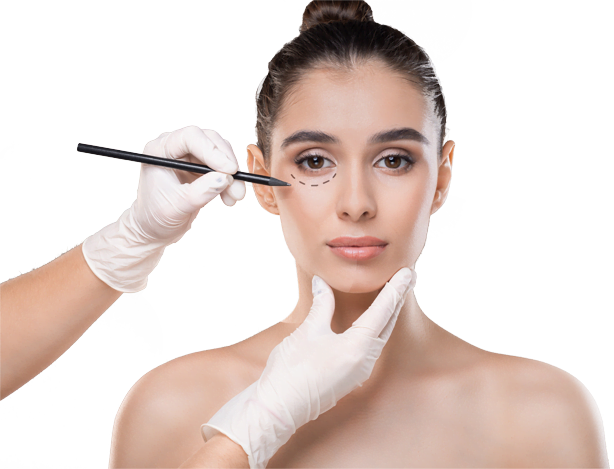Forehead contouring is a cosmetic surgery that can reshape the forehead and brow bone to create a more feminine and harmonious facial profile. It can help reduce the prominence of a masculine or protruding brow bone, smooth out the forehead, and enhance the shape and position of the eyebrows. In this article, we will explore the benefits of forehead contouring for a more feminine appearance, as well as the procedure, recovery, and risks involved.

Table of Contents
What is forehead contouring?
Forehead contouring is a type of craniofacial surgery that involves reconstructing the protruding brow bone and reshaping the orbital bones to achieve a softer, more feminine appearance1. It can often be performed in conjunction with brow lift and hairline lowering/scalp advancement procedure for an overall aesthetically pleasing result1.
The procedure can be done in two ways: burring or setback. Burring involves using a drill to file down the excess bone and create a smoother forehead. Setback involves cutting the bone and setting it back to reduce its projection. The choice of technique depends on the amount of reduction needed and the thickness of the bone.
The procedure is typically done under general anesthesia and local anesthesia in the forehead area to reduce pain and bleeding. The surgeon makes an incision along or behind the hairline to access the brow bone. The incision is carefully made to preserve the hair follicles and nerves. The surgeon then reshapes the bone using burring or setback technique, and sutures the skin together in a way that minimizes scar formation and is hidden by the hairline upon hair regrowth.

What are the benefits of forehead contouring?
Forehead contouring can offer several benefits for people who want to achieve a more feminine appearance, such as:
- Smoother forehead. Forehead contouring can eliminate the bumps or ridges on the forehead that can create a harsh or masculine look. A smoother forehead can also reflect light better and make the skin look more radiant.
- Softer facial profile. Forehead contouring can reduce the prominence of the brow bone and create a more concave or curved forehead that is more typical of female faces. A softer facial profile can also balance the proportions of other facial features and enhance the overall beauty.
- Increased facial symmetry. Forehead contouring can correct any asymmetry or unevenness of the forehead or brow bone that can affect the harmony of the face. A symmetrical face can also improve one’s self-confidence and attractiveness.
- Higher or arched eyebrows. Forehead contouring can lift or reposition the eyebrows to create a more feminine and expressive look. Higher or arched eyebrows can also open up the eyes and make them look bigger and brighter.

What are the risks and complications of forehead contouring?
As with any surgery, forehead contouring carries some risks and complications, such as:
- Infection. Infection can occur at the site of the incision or in the bone. Antibiotics are usually prescribed to prevent or treat infection.
- Bleeding. Bleeding can occur during or after the surgery, which may require additional intervention or blood transfusion.
- Nerve damage. Nerve damage can occur due to injury or compression of the nerves in the forehead area, which may cause numbness, tingling, or weakness in the forehead or scalp.
- Scarring. Scarring can occur along or behind the hairline, which may be visible or affect hair growth. Scarring can be minimized by proper wound care and scar treatment.
- Asymmetry. Asymmetry can occur due to uneven bone reduction or healing, which may require revision surgery to correct.
- Dissatisfaction. Dissatisfaction can occur due to unrealistic expectations or poor communication with the surgeon, which may affect one’s self-esteem or happiness.
What is the recovery process after forehead contouring?
The recovery process after forehead contouring varies depending on the individual and the extent of surgery, but generally involves:
- Pain management. Pain medication is usually prescribed to relieve any discomfort or pain after surgery.
- Swelling and bruising. Swelling and bruising are common after surgery, which may last for several weeks. Ice packs, elevation, and compression can help reduce swelling and bruising.
- Wound care. Wound care involves keeping the incision clean and dry, applying antibiotic ointment, changing dressings, and avoiding infection.
- Suture removal. Sutures are usually removed within 10 days after surgery.
- Activity restriction. Activity restriction involves avoiding strenuous exercise, heavy lifting, bending, or rubbing for at least 6 weeks after surgery.
- Sun protection. Sun protection involves avoiding sun exposure, wearing sunscreen, hats, or scarves to protect the incision from sun damage.
- Follow-up visits. Follow-up visits involve seeing the surgeon for post-operative checkups, monitoring healing progress, addressing any concerns or complications, and evaluating results.
Conclusion
Forehead contouring is a cosmetic surgery that can reshape the forehead and brow bone to create a more feminine and harmonious facial profile. It can offer several benefits, such as smoother forehead, softer facial profile, increased facial symmetry, and higher or arched eyebrows. However, it also carries some risks and complications, such as infection, bleeding, nerve damage, scarring, asymmetry, and dissatisfaction. The recovery process involves pain management, swelling and bruising reduction, wound care, suture removal, activity restriction, sun protection, and follow-up visits. Forehead contouring can be a life-changing procedure for people who want to achieve a more feminine appearance, but it requires careful consideration, consultation, and preparation.
FAQs
- Q: How much does forehead contouring cost?
- A: The cost of forehead contouring depends on several factors, such as the surgeon’s fee, the anesthesia fee, the facility fee, the technique used, the extent of surgery, and the geographic location. According to RealSelf2, the average cost of forehead contouring in the United States is $7,500.
- Q: How long does forehead contouring last?
- A: Forehead contouring is a permanent procedure that can last for a lifetime. However, aging and gravity may affect the results over time, which may require additional procedures to maintain or enhance the results.
- Q: Who is a good candidate for forehead contouring?
- A: A good candidate for forehead contouring is someone who has a prominent or masculine brow bone that affects their facial harmony or gender identity. A good candidate should also be in good physical and mental health, have realistic expectations, and be willing to follow the surgeon’s instructions.
- Q: How do I find a qualified surgeon for forehead contouring?
- A: To find a qualified surgeon for forehead contouring, you should do some research and look for a board-certified plastic surgeon who has experience and expertise in craniofacial surgery and facial feminization surgery. You should also check their credentials, reviews, before-and-after photos, and consultation process.
- Q: What are the alternatives to forehead contouring?
- A: The alternatives to forehead contouring are non-surgical or minimally invasive procedures that can improve the appearance of the forehead or brow bone, such as Botox injections, dermal fillers, fat grafting, or thread lifts. However, these alternatives may not provide the same degree of correction or lasting results as forehead contouring.

